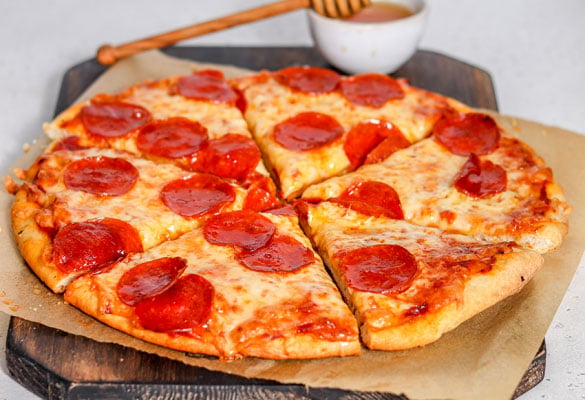Pizza: A Slice of Culture, Comfort, and Creativity
The Origin Story: Where Pizza Came From
Pizza journey starts in the bustling streets of Naples, Italy, where it was first crafted as a humble meal for the working class. Back in the 18th and 19th centuries, it was sold by street vendors to people who needed something affordable, quick, and satisfying. It was originally just flatbread topped with ingredients like garlic, lard, salt, and sometimes cheese or anchovies.
Then came the game-changer: tomatoes. Though originally thought to be poisonous in Europe, tomatoes became a staple in Italian cooking by the 1700s. Once Neapolitans began topping flatbreads with tomato, the first versions of what we recognize today as pizza started to emerge. In 1889, a chef named Raffaele Esposito famously created the Margherita pizza, named after Queen Margherita of Savoy, symbolizing the Italian flag with its red (tomato), white (mozzarella), and green (basil).
What started as a street snack soon turned into a national treasure. IT was eventually brought to America by Italian immigrants and began evolving rapidly in the U.S., leading to the dozens of unique styles we know today.
Types of Pizza: A Delicious Diversity
When it comes to IT , there’s something for everyone. From deep-dish lovers to thin-crust fanatics, the variety of IT styles is endless. In the U.S. alone, styles like New York-style, Chicago deep dish, Detroit square IT , and California gourmet pizza have made headlines and sparked debates over which is best.
New York-style IT , for example, is famous for its large, foldable slices and crispy-yet-chewy crust. It’s typically topped with tomato sauce and mozzarella, but there’s room for all kinds of toppings, from pepperoni to pineapple (a controversial choice, we know). Chicago-style deep dish is another beast altogether, with a buttery, thick crust and layers upon layers of cheese, sauce, and toppings that you almost need a fork and knife to tackle.
Beyond these classics, there are also global variations worth exploring. Turkish pide, Middle Eastern manakish, and Indian naan pizza all offer regional spins on the concept. This proves that pizza isn’t just a food — it’s a canvas for culture and creativity.
Why We Love Pizza: Comfort, Cravings, and Community

IT isn’t just a food — it’s an emotional experience. There’s something about the combination of warm, gooey cheese, tangy tomato sauce, and crispy dough that taps into our brain’s pleasure centers. Scientifically, IT hits all the major food cravings: carbs, fats, salt, and umami.
It’s also the ultimate comfort food. Whether it’s movie night, game day, a party, or just a Friday night alone at home, IT fits the occasion perfectly. It doesn’t judge your mood or your toppings. It’s equally happy to be shared with friends or devoured solo while binge-watching your favorite series.
But IT is more than just indulgence — it’s a symbol of community. Think about it: people rarely eat IT alone in social settings. It’s made for sharing. Families bond over it, coworkers eat it during late-night projects, and friends gather around it for birthdays and celebrations. IT brings people together in a way few other foods can.
Homemade vs. Restaurant Pizza: A Tasty Debate
With the rise of food delivery apps and gourmet pizzerias, it’s never been easier to enjoy pizza from a restaurant. But homemade IT has its own special charm — and a growing fanbase. Making pizza at home gives you full control over every element, from the dough thickness to the sauce flavor and toppings.
One of the best things about making IT yourself is the chance to experiment. You can try whole wheat dough, cauliflower crust, or gluten-free alternatives. Sauces can range from classic marinara to pesto, white garlic sauce, or even BBQ. Toppings? Anything goes. Go traditional with pepperoni and mushrooms, or bold with figs and goat cheese.
That said, restaurant IT has its strengths too. Professional ovens can reach extremely high temperatures that create the perfect crispy crust and melty top that’s hard to replicate at home. Pizzerias also often use secret family recipes, imported ingredients, and years of technique to craft their masterpieces.
Ultimately, whether you’re pulling a homemade pie out of your oven or unboxing a piping-hot pizza from your favorite joint, the joy is the same — delicious and deeply satisfying.
Pizza in Pop Culture: More Than Just a Meal
IT isn’t just popular in kitchens — it’s a pop culture icon. From its appearances in movies, TV shows, and cartoons to memes and fashion, pizza has become a symbol of fun, youth, and rebellion. Who can forget the Teenage Mutant Ninja Turtles obsessing over pizza, or the pizza rat from New York who became a viral star?
IT also shows up in art, advertising, and even political discussions. It’s been used as a symbol of everything from capitalism to globalization. In the age of social media, IT is one of the most Instagrammed foods, with influencers snapping mouthwatering slices and neon-lit pizzerias from every corner of the globe.
Merchandise like pizza-themed socks, pool floats, phone cases, and even engagement rings proves that IT isn’t just something we eat — it’s something we celebrate. It has transcended food and become a lifestyle choice for many.
The Future of Pizza: Innovation Meets Tradition
As the world changes, so does IT . Technology and culinary creativity have taken pizza into new frontiers. We now have vegan pizzas made with plant-based cheeses, gluten-free crusts, and even 3D-printed pizzas for astronauts. Innovation is happening in both toppings and techniques.
At the same time, there’s a growing trend to return to tradition — artisan pizzerias focusing on authentic ingredients, wood-fired ovens, and slow-fermented dough. People are increasingly valuing quality over convenience, and pizza makers are responding by going back to their roots while adding a modern twist.
Sustainability is also becoming a key factor. From using eco-friendly packaging to sourcing local and organic ingredients, the IT industry is evolving in step with environmental consciousness. Even AI is getting involved, helping optimize deliveries and suggest new combinations based on your preferences.
So whether you’re a traditionalist or a trend-chaser, the future of IT promises something exciting — and most importantly, something delicious.
Conclusion: Pizza — A Slice of Life
IT is more than food — it’s a symbol of comfort, connection, creativity, and culture. It has a rich history, a diverse present, and an innovative future. Whether you prefer it thin, thick, cheesy, spicy, vegan, or overloaded with toppings, pizza speaks a universal language: joy.
So the next time you grab a slice, remember — you’re not just eating IT . You’re tasting a piece of history, sharing in a global tradition, and indulging in something that brings people together from all walks of life. That’s the true magic of pizza.
YOU MAY ALSO READ
Pizza
